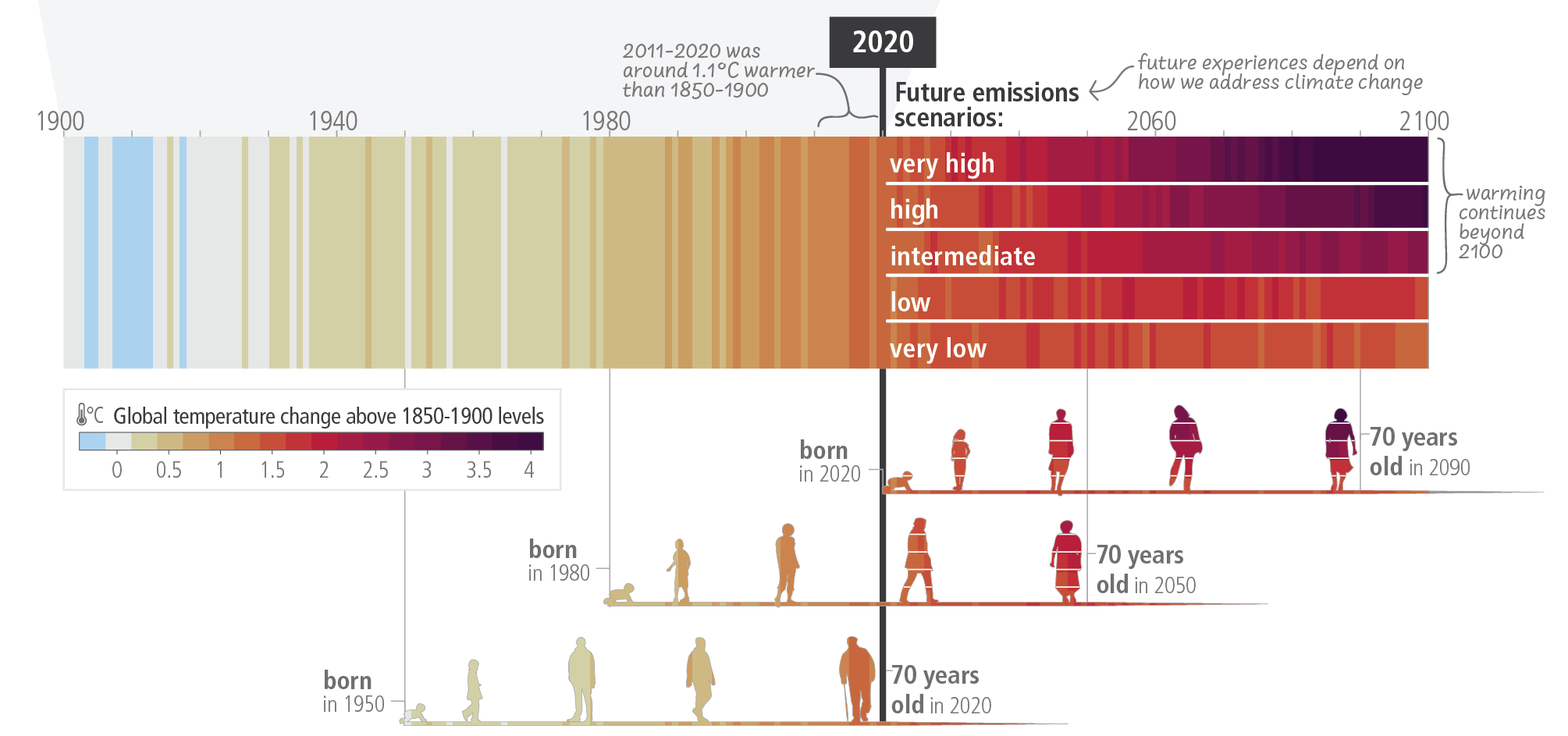The IPCC report on mitigation (2022) shows that we now have the means with which to avert disastrous increases in emissions and hence global warming. Wind turbines, solar panels, electric vehicles, regenerative farming, and heat pumps – the technology and know-how to end the fossil fuel paradigm are at an all-time high.
What is more, the old paradigm of fossil fuel driven prosperity is no longer the only option. The economic benefits of the transition to a net-zero carbon era, and therefore keeping average global temperatures below 2 degrees Celsius, are much greater than the costs of its implementation.
“Overall, the latest studies on the net economic implications of decarbonisation – which also account for avoided climate damages – point to overall benefit from the transition,” explains economics professor at Bocconi University Valentina Bosetti, when talking to Carbon Brief:
A statement that is also backed up by a paper published in the Oxford Open Climate Change journal whereby future scenarios on the economic impact of lowering emissions lead to higher benefits than costs.
“Rapid climate action will inexorably generate economic benefits from avoided impacts in the second half of the century,” says the paper’s lead author and CMCC scientist Laurent Drouet. “Those benefits will be much higher than the transition costs for the next decades.”
The WGIII report also provides a wide variety of practical solutions with which to meet our current climate objectives. According to CMCC Researcher Massimo Tavoni, when speaking during the CMCC webinar on climate change mitigation and the WGIII report: “the report shows that there are many ways to reach net zero CO2 systems […] we don’t know exactly what a net zero future looks like but we now know that there are different ways for us to reach it.”
The report lays bare that the technical capacity to meet our climate objectives exists, but that these need to be matched by a combination of long and short term policies and strategies that can put these tools to use and lead us to peak emissions by 2025 and to reach net zero emissions by 2050.
When talking to The Atlantic, Professor Peter Erickson, climate-policy program director at the Stockholm Environment Institute, explains that “The new IPCC report repeatedly finds that the 1.5 degree Celsius goal is technically feasible, it also establishes that the pace of institutional change required to achieve such a technical transition would have no historical precedent.”
Policy to match technology
“The most important message from the new report is that very powerful solutions to maintain a safe climate on Earth exist in all sectors,” explains Reyes Tirado, senior scientist and expert on agriculture and climate change with Greenpeace Research Laboratories, University of Exeter, when interviewed by Greenpeace.
However, Tirado also goes on to comment: “The dramatic picture, on the other hand, shown by the report, is that sadly the current climate policies from governments are setting us up for failure.”
The view that policy is not keeping up with technological advances that can help us mitigate the worst effects of climate change is widespread.
“From the scientific point of view, there has been immense progress: thirty years ago we didn’t have all this knowledge about climate science and the potential technological solutions. However, on the policy side, we are doing a lot worse. Little has been done to follow the advice of the IPCC and in fact, emissions have continued to increase over the last 30 years,” says Carlo Carraro, President Emeritus and Professor of Economics at Ca’ Foscari University of Venice and Vice-Chair of the IPCC WGIII, when talking to the Italian daily La Repubblica.
A view that climate journalist Amy Westerfield also outlines when writing for The Guardian, where she explains that: “The report made one thing abundantly clear: the technologies and policies necessary to adequately address climate change exist, and the only real obstacles are politics and fossil fuel interests.”
“We have the instruments to transition but the question is more about shifting investments from fossil fuels and towards alternative sources,” echoes Tavoni, who also explains that: “the latest IPCC report reveals a lack of investment. Current financial flows are three to six times lower than what is needed by 2030 to reach the 1.5 to 2 degrees Celsius goal.”
However, this doesn’t mean that the economic resources are not available but simply that they are currently being funneled in the wrong direction.
According to Simon Lewis, professor of global change science at University College London and University of Leeds, “The most heartening section of the report is on alternatives to fossil fuel use. The overarching solution to our energy needs is to electrify everything we can, from heating buildings to transport, and power everything using clean renewables and storage. We are getting a huge helping hand from great leaps forward in clean technology.”
In fact, the IPCC Report on Mitigation of Climate Change reveals that the cost of solar energy has fallen by 85%, wind energy by 55%, and lithium-ion batteries by 85%. All of which highlights the technological potential and economic opportunity behind a clean energy transition.
The LA Times also points to the newfound details on opportunities contained in the report and the need for political action: “We can still prevent the worst devastation with radical action to cut carbon emissions over the next decade. That will take ambitious and committed leadership from the U.S. and other industrialized nations — and a reversal of political lethargy that has slowed progress since the Paris climate agreement in 2015.”
The issue of political action is also touched on by the South China Morning Post which focuses on the need for Asia to step up its game as the region, “also has a major role in the solutions. Its rainforests, mangroves, and reefs – and even its financial hub of Hong Kong – all have a key part to play.”
Tools available across all economic sectors
Across all economic sectors, there are potential levers that can be used to initiate effective mitigation strategies. The agriculture, forestry, and other land-use sectors are a case in point.
“Protecting forests, changing diets, and altering farming methods could contribute around a quarter of the greenhouse gas cuts needed to avert the worst impacts of climate change,” writes journalist Leah Douglas for Reuters.
In fact, the agriculture, forestry, and other land-use sectors can provide up to 20 to 30% of global mitigation potential by 2050. What is more, most of the instruments for this are already available and if used sustainably can have positive co-effects on biodiversity ecosystems and the quality of water and soil.
Similar progress is within reach in the area of transport where, according to Alan Jenn, assistant professional researcher in transportation at the University of California, cutting emissions from transport by up to 90% of current levels is possible by 2050.
“Falling costs for renewable energy and electric vehicle batteries, in addition to policy changes, have slowed the growth of climate change in the past decade,” Jenn says.
Furthermore, some point to the IPCC reports linking of social justice and environmental mitigation as another area for opportunities . “People are beginning to realize how serious the climate crisis is, and that the ways to meet the challenges of the climate crisis – moving to low-carbon energy, looking after the environment, shifting transport – tend to also improve energy security, justice, social concerns, there are a lot of win-wins and co-benefits,” says Catherine Mitchell, professor of energy policy at Exeter University, and one of the two coordinating lead authors on the chapter focused on policy.
According to Elena Verdolini, senior scientist at the RFF-CMCC European Institute on Economics and the Environment and Lead Author of the Working Group III report, “to take advantage of all this potential and bring it to scale the report looks at two main areas: the first is technology and innovation and they play an important role because in the next few years we need to push research and new technologies […] and the second lever regards policies and financial mechanisms. From taxing emissions and putting standards to promoting technological development with policies.”
Room for cautious optimism
“Today we have technological solutions available and which make financial sense that can cut emissions and even half them by 2030. When the last IPCC report was published 6 years ago there was nothing like this,” says Carlo Carraro.
We need to do much more to tackle climate change, but there is some good news for once.
In @Nature this week, @ClimateFran and I point out that falling costs of clean energy and strengthening climate policies move us away from the darkest climate futures: https://t.co/e6ZWNeddnd pic.twitter.com/ad0OY7AfU9
— Zeke Hausfather (@hausfath) April 13, 2022
Over recent years the literature on current climate policies such as nationally determined contributions and net-zero commitment outcomes has increased exponentially, revealing not only the shortfalls but also the progress being made.
According to climate scientist Zeke Hausfather, growth in carbon dioxide emissions has slowed notably over the past decade, and as the recent IPCC WGIII report notes, emissions are projected to plateau in coming years under current policies and commitments. Regardless of whether this is happening fast enough, it reveals that new technologies are leading to progress in decarbonisation.
The message is also picked up by The Sydney Morning Herald: “The report shows that the rate of growth of emissions is reducing in line with global agreements and reduction policies. This is clear evidence that emission reduction efforts can work. This has not always been apparent.”
The Australian paper also discusses how the economic advantages of acting “ambitiously on climate change are relatively cheap in the long term. This is partly due to the fact that not acting ambitiously on global warming carries horrific costs that Australia knows well after seasons of drought, fire, flood, and coral bleaching.”
The IPCC report shows that we are now at a crossroads. We have a more developed understanding of the climate, the cost of inaction, and the economic benefits of action. We also have the technology with which to address our impacts. What is missing are the right policies with which to capitalize on this opportunity and meet the challenge before us head on.







